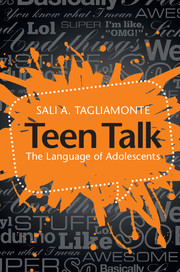Book contents
- Frontmatter
- Dedication
- Contents
- List of figures
- List of tables
- Preface
- 1 What's all the fuss about teen language?
- 2 Teens talking
- 3 Methods: how to tap teen language?
- 4 Quotatives: I'm like,“Oh my God!”
- 5 Intensifiers: upping the ante – super cool!
- 6 How do you start a sentence?
- 7 Sentence enders: finish with a flourish
- 8 Generics: stuffology
- 9 Just: just what?
- 10 Adjectives: the good, bad, and lovely
- 11 Other funky teenage features: You know what? I dunno. Whatever!
- 12 Internet language: everyone's online
- 13 Are they always going to talk like that?
- Notes
- References
- Author index
- Keyword index
1 - What's all the fuss about teen language?
Published online by Cambridge University Press: 05 June 2016
- Frontmatter
- Dedication
- Contents
- List of figures
- List of tables
- Preface
- 1 What's all the fuss about teen language?
- 2 Teens talking
- 3 Methods: how to tap teen language?
- 4 Quotatives: I'm like,“Oh my God!”
- 5 Intensifiers: upping the ante – super cool!
- 6 How do you start a sentence?
- 7 Sentence enders: finish with a flourish
- 8 Generics: stuffology
- 9 Just: just what?
- 10 Adjectives: the good, bad, and lovely
- 11 Other funky teenage features: You know what? I dunno. Whatever!
- 12 Internet language: everyone's online
- 13 Are they always going to talk like that?
- Notes
- References
- Author index
- Keyword index
Summary
There's always going to be a generation gap because you're never going to change teenagers. Even in the fifties they were like being rebellious and going against them by wearing poodle skirts and burning their bras in the sixties. So teenagers aren't ever – are never gonna change.
(Mindy Chow, 17)This book is about the way teenagers talk. It is not about the way adults think teenagers should talk. It is about the way they do talk. What you will read about in this book is based on what I have learned from listening and questioning and from doing what sociolinguists do – analyzing everyday talk. In this chapter I bring together the prevailing ideas about teen language.
The rise of teen power
As a backdrop for the investigation of teen language, it is important to contextualize the historical and cultural context. Consider the events and developments that have typified the twentieth century. There have been two world wars. The United States has risen as a world power. Public broadcasting has developed, including talking movies in the 1920s and, after 1950, television. There have been colossal, widespread technological developments, including the World Wide Web in the 1990s. English has become a global language (Crystal, 2003).
These developments have innumerable implications for language change, and for the English language in particular. Class structure, a vital concomitant of language variation and change (e.g. Chambers, 2003a) has flattened and literacy has risen (Chambers, 2003b: 100–101), rural dialects have declined and urbanization has increased. There have been unprecedented changes in communication and media, and popular youth culture has developed. Many of these changes converge in grandstanding the very youngest sectors of the speech community. The notion of the teenage years as a discrete stage in life did not even exist before the twentieth century, let alone tweens (the 8–12-year-olds) who are now becoming a major advertising market. Moreover, the focus on youth is strengthening with pervasive geographic, social, and occupational mobility, as well as the increasing tendency towards new types of communication (i.e. text messaging, email, instant messaging, etc.), which are fundamentally changing the types of contacts young people have on a daily basis. As we shall see, all these sociocultural changes may have added to the influence of teenagers as the drivers of language change.
- Type
- Chapter
- Information
- Teen TalkThe Language of Adolescents, pp. 1 - 7Publisher: Cambridge University PressPrint publication year: 2016

